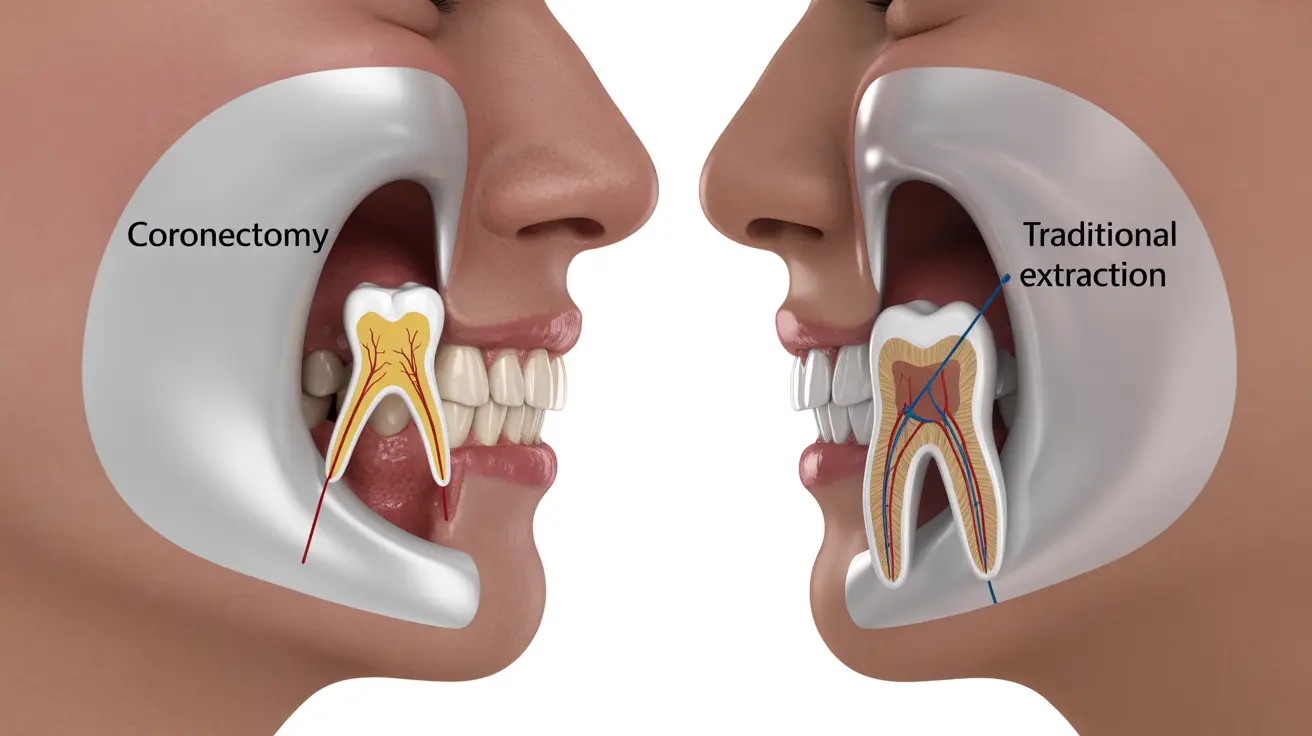When it comes to wisdom tooth removal, patients may be presented with two main surgical options: a traditional full extraction or a coronectomy. Understanding the differences between these procedures is crucial for making an informed decision about your dental health, especially when dealing with complex cases involving impacted wisdom teeth.
This comprehensive guide explores the key distinctions between coronectomy and traditional extraction procedures, helping you understand which option might be more suitable for your specific situation.
What is a Coronectomy?
A coronectomy is a specialized dental surgical procedure where only the crown portion of the tooth is removed while intentionally leaving the roots in place. This technique is particularly relevant for wisdom teeth that are situated close to sensitive nerve structures in the jaw.
Unlike a full extraction, this partial removal approach helps minimize the risk of nerve damage, particularly to the inferior alveolar nerve that runs through the lower jaw.
Understanding Traditional Wisdom Tooth Extraction
Traditional wisdom tooth extraction involves the complete removal of the tooth, including both the crown and roots. This is the most common approach for wisdom tooth removal when there are no specific anatomical concerns that would make full extraction risky.
When Each Procedure is Recommended
The choice between coronectomy and extraction typically depends on several factors:
- Proximity to vital nerves
- Degree of tooth impaction
- Overall oral health status
- Presence of infection or disease
- Patient age and healing capacity
Benefits of Coronectomy
Coronectomy offers several advantages in specific situations:
- Reduced risk of nerve damage
- Less invasive procedure
- Shorter recovery time in some cases
- Lower risk of complications in high-risk cases
- Preservation of jaw bone structure
Risks and Considerations
While coronectomy can be beneficial, it's important to understand potential risks:
- Possible need for future root removal
- Migration of retained roots
- Risk of infection around retained roots
- Potential for incomplete healing
- Not suitable for all cases
Recovery and Aftercare
The recovery process differs between these procedures. Generally, coronectomy patients may experience:
- Less post-operative swelling
- Reduced pain compared to full extraction
- Shorter initial recovery period
- Need for long-term monitoring of retained roots
Frequently Asked Questions
What is the difference between a coronectomy and a full wisdom tooth extraction?
A coronectomy involves removing only the crown portion of the tooth while leaving the roots in place, whereas a full extraction removes the entire tooth, including both crown and roots. This difference is particularly important when the tooth roots are close to sensitive nerve structures.
When is a coronectomy recommended instead of extracting the entire wisdom tooth?
A coronectomy is typically recommended when wisdom teeth roots are very close to the inferior alveolar nerve, making complete extraction risky. It's also considered when traditional extraction poses a high risk of nerve damage or other complications.
What are the benefits and risks of having a coronectomy compared to a traditional extraction?
The main benefit of coronectomy is reduced risk of nerve damage. However, risks include potential root migration, need for future procedures, and possible infection. Traditional extraction offers complete removal but may carry higher risks of nerve damage in complex cases.
How long is the recovery time after a coronectomy versus a full tooth extraction?
Initial recovery from a coronectomy is often shorter than full extraction, typically lasting 3-7 days. However, patients need long-term monitoring of retained roots. Full extraction recovery usually takes 7-14 days but doesn't require long-term root monitoring.
Can the roots left behind after a coronectomy cause problems later on?
While most retained roots remain stable, they can potentially migrate, become infected, or require removal later. Regular monitoring through X-rays and dental check-ups is essential to detect any complications early.




